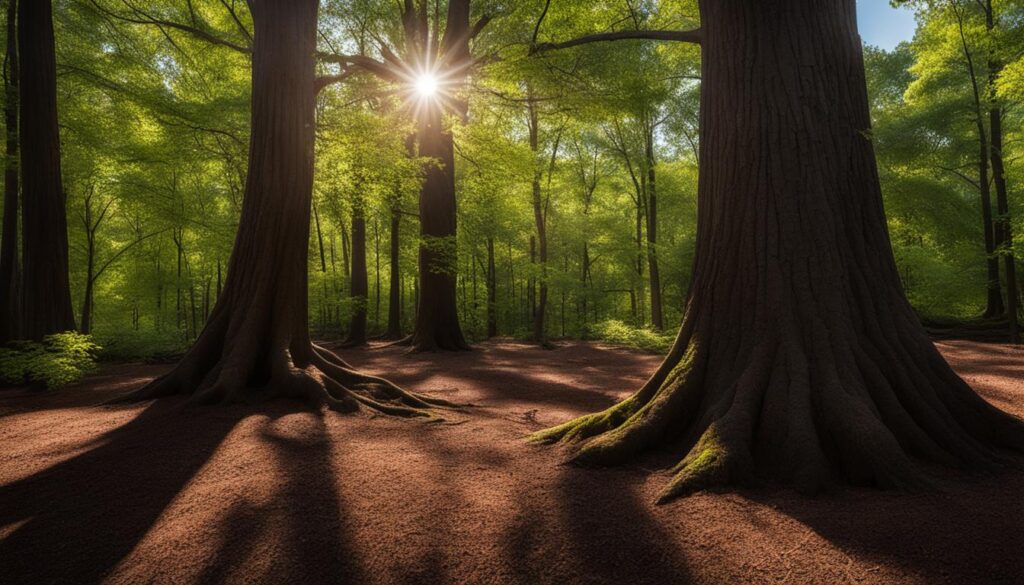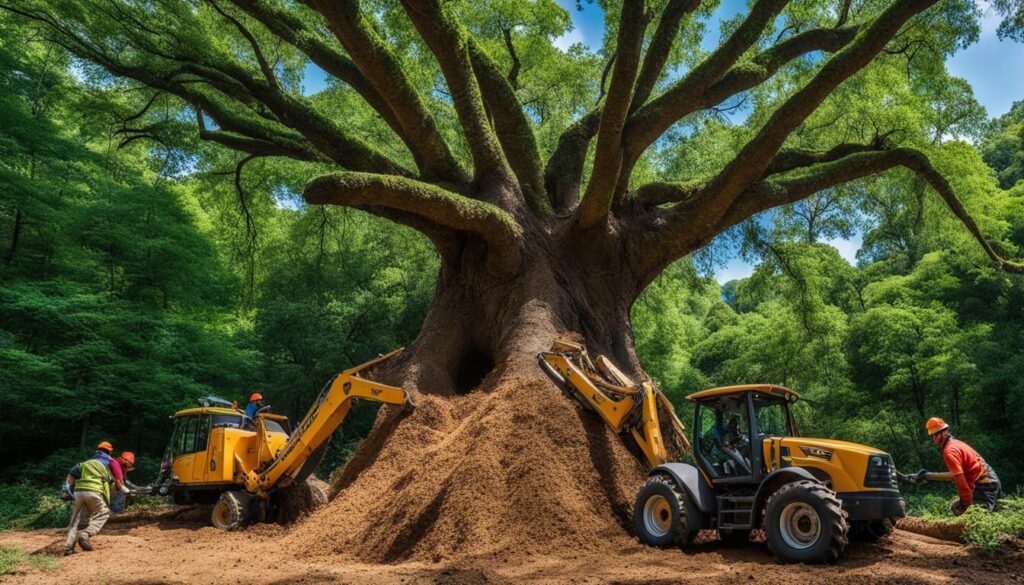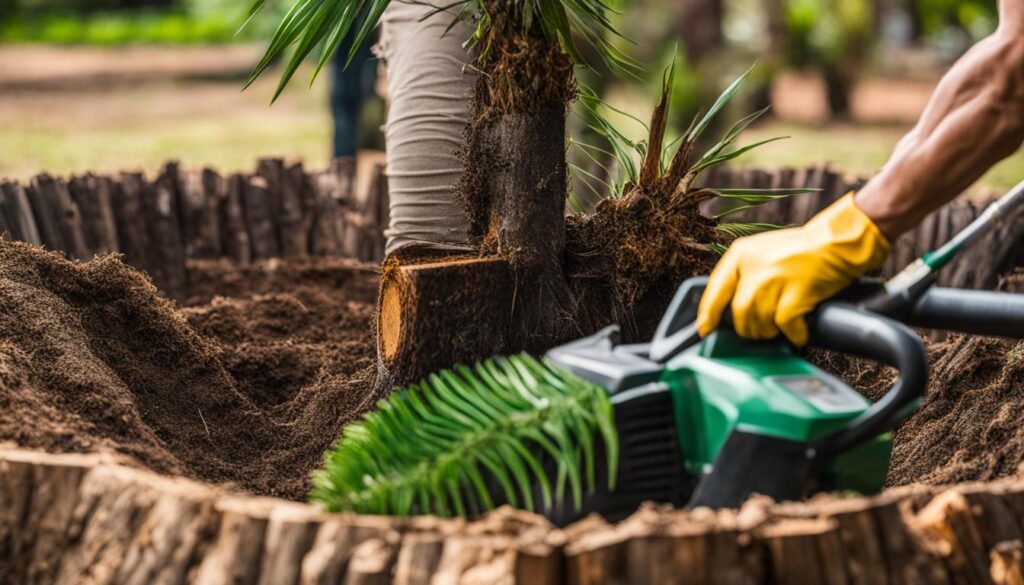As a gardening enthusiast and landscape caretaker, I understand the significant role mulch plays in nurturing the robustness of large trees. By meticulously mulching around large trees, not only do I cater to their basic needs, but I also enforce a guard against environmental extremes. Throughout my experience, I have assimilated a collection of invaluable tree mulching tips that are sure to enhance the mulching benefits for large trees. The practice involves covering the soil surface with an organic material such as woodchips, which acts as an efficient insulator for regulating temperature, retaining soil moisture, and improving overall soil health—a crucial factor for the longevity of our arboreal giants.
Choosing to mulch around big trees with materials like woodchips, I’ve seen firsthand how it can reduce root competition and foster a breathable, nutrient-rich soil environment. The following insights have been gleaned from my own diligent care for these majestic natural monuments and my commitment to maintaining their splendor for future generations to cherish.
Key Takeaways
- Select the right type of mulch, ideally woodchips, to provide numerous benefits to large trees.
- Create a 2-4 inch deep mulch ring that extends 4-6 feet from the trunk to protect against temperature extremes and retain moisture.
- Avoid potentially harmful ‘volcano mulching’ and opt for a balanced approach to enhance soil structure.
- Utilize resources like Chip Drop for accessing quality mulching materials that are freely available.
- Embrace a mulching strategy that prioritizes the tree’s health while contributing to the aesthetic appeal of the landscape.
- Understand the importance of proper placement and depth to prevent decay and disease.
- Continuously educate oneself on the evolving best practices in mulching to ensure the thriving of large trees.
Understanding the Foundations of Tree Mulching
As someone passionate about arboriculture, I’ve seen firsthand the importance of mulching around trees, particularly large ones that grace urban landscapes. The act of placing mulch is more than an aesthetically pleasing gesture; it’s a critical component of tree care that replicates the nurturing environment found in natural forests. In these wild ecosystems, the soil is organically enriched by the continuous cycle of falling leaves and branches, enhancing the vitality and stability of towering trees.
When I talk to novice gardeners or homeowners, I emphasize the benefits of mulching around trees. Not only does mulch serve an ornamental role, but it’s also essential in safeguarding soil from erosion, providing nutrients as it decomposes, and playing a significant role in water conservation—benefits that are especially crucial in the concrete confines of city life where soils often lack the porosity and richness of their rural counterparts.
What is Tree Mulch and Why is it Important?
Mulch is the guardian of a tree’s root system, particularly in urban settings where trees face an array of challenges, from compacted nutrient-poor soils to increased thermal stress. Its importance cannot be overstated, and I make it my mission to educate people on proper mulching for large trees. It is not just a layer; it’s a barrier that conserves moisture, reduces weeds, and provides a gradual influx of organic matter.
The Role of Mulch in Soil Protection and Tree Root Health
The role mulch plays in enhancing soil protection and tree root health is akin to that of a natural buffer. By creating an optimal surface barrier, it prevents soil compaction, facilitates moisture retention, and moderates temperature extremes. This in turn contributes to healthier tree roots that are less susceptible to stress and are better equipped to absorb nutrients.
Organic vs Inorganic Mulch: Pros and Cons
When people query me about the best choice for mulching, I advocate for organic mulch. The contrast between organic and inorganic mulch types is stark, with organic mulch such as wood chips, leaf litter, or compost mix winning my favor every time for its soil enriching properties. In contrast, inorganic mulch like rubber or stones, while they may have their place in certain landscapes, do not offer the same long-term benefits to soil health, making them a less favorable choice for supporting the thriving ecosystems that large trees need.
The Benefits of Mulching Around Large Trees
When I think about landscape management, especially for large trees, the question often arises: why mulch around trees? The answers are numerous and compelling, echoing the natural mechanisms of a forested environment. If you’re pondering, “Do trees need mulch?” or “Should I mulch around mature trees?” – the following insights into mulching depth for large trees will illuminate the reasons behind this horticultural practice.
Moisture Preservation and Weed Suppression
Imagine a world where the soil retains moisture like a well-soaked sponge, providing my large trees with a constant water source vital for their growth and sustenance. That scenario isn’t farfetched; it’s the reality achieved through mulching. By applying a proper layer of mulch around the trees, evaporation is reduced considerably, allowing roots to luxuriate in much-needed hydration. Concurrently, this same barrier suppresses those pesky weeds that vie for the same precious resources, ensuring my trees thrive unchallenged.
Temperature Control for Root Systems
Weather extremes – the scorching summer heats and the bone-chilling frosts of winter – can cause unwarranted stress on the root systems of trees. Thankfully, mulch serves as the perfect insulator that maintains an equitable soil temperature. By mulching around my trees, I provide a cozy buffer that keeps the roots cool during hot spells and offers a warm embrace when the mercury drops.
Enhancing Soil Fertility Through Natural Decomposition
A fundamental aspect of soil fertility is the presence of organic matter, which is continually replenished in natural forests through decay. In a similar fashion, as the mulch around my trees decomposes, it transforms into a rich humus that augments the soil structure and infuses it with nutrients. This organic alchemy is the cornerstone of fostering an environment ripe for growing robust and resilient roots. Undoubtedly, observing and nurturing this cycle of life energizes not only the soil but also my passion for arboriculture.
Selecting the Appropriate Mulch for Your Trees
When I consider the best mulch for large trees, several essential variables come to mind. Organic mulching materials are top of my list, particularly those capable of enhancing soil as they break down. Among the varieties of mulching materials for large trees, wood chips often emerge as the preferred choice, thanks to their ability to condition the soil, ultimately benefiting tree health.
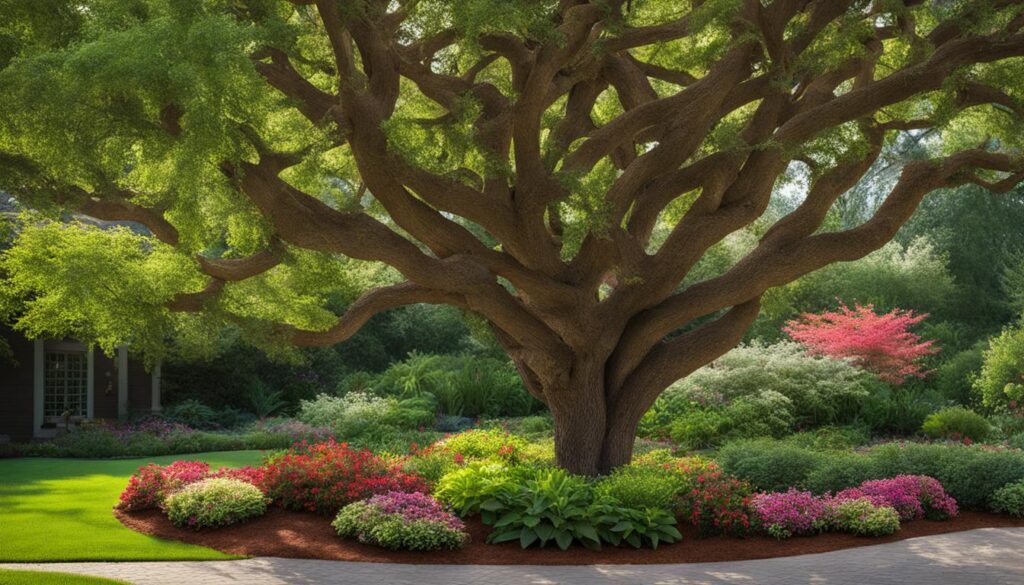

Expert mulching strategies for large trees dictate that I assess the specific requirements of each tree, factoring in its size, the local climate, and its stage of growth. By adopting a responsive approach to how to mulch around large trees, I aim to not only safeguard their majestic roots but also to provide a nutrient-rich foundation that supports their growth year after year.
I’ve found that the interaction between the mulch and soil drainage properties is key. If the area around the trees drains poorly, I might opt for a lighter, more aerating mulch to prevent waterlogging, which can be detrimental to roots. However, in a well-draining site, a denser mulch might be best to maintain essential soil moisture. No matter what, ensuring the mulch does not pile against the trunk to prevent unwanted moisture and pests ensures the vitality of these stately giants.
Proper Mulching Techniques for Large Trees
When I approach the care of large trees, my focus is zeroed in on executing proper mulching techniques to ensure their health and vitality. A well-mulched tree can reap considerable benefits, making it a practice I heavily endorse and meticulously apply in every landscaping project.
Recommended Mulching Depth for Optimal Growth
My mulching routine adheres to a specific depth that promotes optimal growth. I maintain a consistent mulch layer of 2-4 inches, understanding that this range is crucial for facilitating proper gas exchange and preventing potential suffocation of tree roots. This depth also aids in retaining moisture and providing an even temperature for the soil underneath, both of which are cornerstones in the narrative of tree mulching benefits.
Expanding the Mulch Ring: The ‘How’ and ‘Why’
Expanding the mulch ring to an ideal 4-6 feet from the tree’s trunk is not a mere arbitrary preference but a carefully considered strategy in my mulching arsenal. This practice goes beyond providing space for root growth; it represents a commitment to reducing grass competition, which can be particularly aggressive around the vital root area. The wider mulch ring is a testament to the rich resources allocated for the tree’s uninhibited growth.
Avoiding Common Mulching Mistakes
It’s equally important to acknowledge what not to do. In my experience, common mulching mistakes such as piling mulch against the tree trunk—often called ‘volcano mulching’—can be detrimental, trapping moisture against the bark and inviting decay. I take care to feather the mulch out towards the edge, giving trees room to breathe and preserving their integrity. This technique is among many mulching tips for large trees that I’ve learned and perfected over the years.
By incorporating these mulching techniques for large trees into my regular tree care routine, I ensure that every tree under my guardianship thrives robustly, benefitting from the protection and nourishment that a proper mulch layer provides.
Addressing Mulch Quality: What to Look for
As I delve into the world of landscaping, particularly on how to mulch around large trees, an understanding of the quality of mulch used becomes paramount. While people commonly debate over grass or mulch around trees, the latter’s benefits can only be fully realized when the mulch itself is of high quality. When evaluating mulch for your towering green giants, you should prioritize medium to coarse textures like wood chips. Not only do they provide a natural aesthetic, but they also prevent soil compaction, thus enhancing water infiltration and air exchange around the roots.
Effective mulching techniques for trees hinge on using mulch that is free from contaminants. Whether you’re mulching around big trees in a public park or in your own backyard, the presence of foreign materials in mulch can lead to less than optimal results, potentially harming the soil and the trees that rely on it. And when it comes to the query of grass or mulch around trees, I advise leaning towards mulch because it better facilitates the gradual enrichment of the soil with the decomposition of organic material, enhancing the tree’s environment for sustainable growth.
Through my experiences, reliable sourcing and the proper rate of decomposition are critical factors that influence mulch quality. The goal is always to create a mulch layer that melts into the landscape over time, gradually releasing nutrients back into the soil. Thus, high-quality mulch serves not just as a cover, but as an active contributor to the health of a tree’s ecosystem. By ensuring you use quality mulch, you apply not just a protective barrier, but you invest in the future vitality of your large trees.
Environmental Considerations and Mulching
As I delve into the subject of mulching around large trees, it’s crucial to recognize the impact of our actions on the environment. My commitment to maintaining a sustainable landscape has led me to explore not only the importance of mulching around trees but also to employ mulching strategies for large trees that resonate with ecological responsibility. The very act of laying down organic matter beneath the towering giants of our backyards and parks is a step toward a greener future.
Maintaining a Sustainable Landscape
In my quest for creating a more sustainable landscape, I’ve discovered the intrinsic value of mulching benefits for large trees. Mimicking the forest’s natural cycle, I layer mulch with the intention of having it break down to replenish the soil, thus closing a loop in the circle of life. The organic materials I choose not only serve the immediate needs of my leafy charges by conserving moisture and discouraging weeds, but they also contribute to the long-term health of the soil ecosystem. This sustainable approach has proven essential in the stewardship of our shared environment.
Local Mulching Resources and Recycling Options
Accessibility to local resources for mulching has considerably lessened my ecological footprint. By using services such as Chip Drop, or by obtaining free municipal woodchips, I actively participate in recycling efforts. This locally sourced mulch minimizes transport-related carbon emissions and encourages community-based recycling programs. It’s a simple yet profound act that underlines the interconnectedness of our environmental efforts and the wellbeing of our large trees.
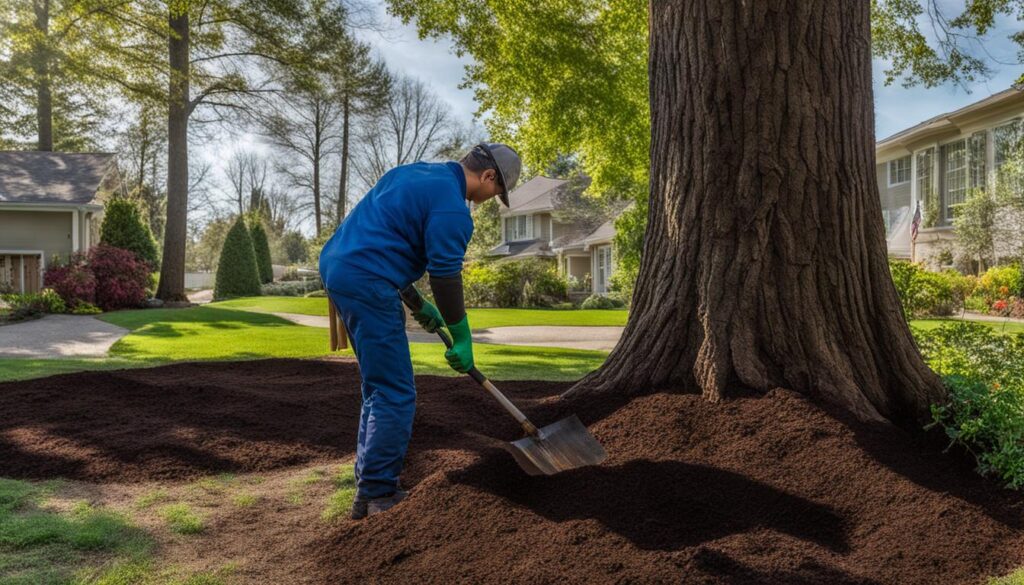

Mulching Around Large Trees: A Year-Round Approach
As a seasoned gardener, I’ve witnessed the dramatic differences in the vitality of large trees with the application of a year-round mulching regimen. Sharing mulching tips for large trees through personal experience and expertise can enlighten others about the importance of this practice. For instance, during the burgeoning spring, I always refresh the mulch to foster optimal conditions for the development of root systems. This simple action is guided by the knowledge that a proper mulching depth for large trees is critical and should be monitored to accommodate rising soil temperatures.
In the midst of autumn’s descent, I prepare my trees for the impending cold by applying a new layer of mulch. This technique not only insulates but also stands as a guardian against frost that seeks to permeate the soil. Regular assessments throughout the year prevent the hazard of overmulching—a misstep which can reverse the very mulching benefits for large trees that I aim to secure. By extending the blanket of mulch to the tree’s drip line and beyond—thus adjusting to its growth—I am able to provide unwavering coverage and support to the ever-expanding root network.
Let my experience stand as both a guide and a testimony to the fact that mulching is not just a task but a craft. With the right mulching techniques for large trees, what begins as an act of maintenance can progress into a thriving, year-round cycle that significantly enriches our green giants.
Mulching and Tree Health: Interconnected Dynamics
As I delve into the relationship between mulching and the well-being of large trees, I’m reminded of the undeniable synergy that exists between them. When I think about tree mulching benefits, it’s clear that the practice is more than just an aesthetic choice; it’s a fundamental component of tree health. I recognize the importance of mulching around trees as not only an enhancement to their natural environment but also a strategic tool for their growth and vitality.
Nutrient Uptake and Improved Resistance Against Diseases
When I mulch around large trees, I am essentially facilitating their access to vital nutrients. The organic mulch breaks down over time, releasing nutrients directly into the soil where tree roots can absorb them. This natural provision of nutrients is crucial for the trees’ strength and helps bolster their resilience against diseases and pests. The connection here is vital — healthy trees are less susceptible to disease and better equipped to fight off any that they encounter.
Mulching as a Preventative Measure for Tree Health Issues
Part of my responsibility in caring for large trees lies in preventive measures. By mulching around large trees, I’m not just reacting to issues, but actively preventing them. Mulch serves as a physical barrier, shielding the tree from potential harm caused by lawn care equipment. This barrier also reduces weed competition, ensuring that trees don’t have to compete for water and other resources. To me, mulching isn’t just about maintenance, it’s about creating a sustainable and robust environment for trees to thrive long-term.
Landscape Aesthetics: Mulching for Visual Appeal
As a professional landscaper, I’ve always stressed the importance of mulching around large trees not merely for their health benefits but also for the significant aesthetic enhancement it brings to any outdoor space. A neatly-applied mulch ring anchors the landscape, injecting both elegance and order. It’s about framing nature’s giants in a way that’s visually arresting, inviting onlookers to appreciate the fusion of utility with beauty. Through my experience, I’ve found that implementing my tree mulching tips doesn’t just serve an ecological purpose but also showcases my commitment to a garden’s artistic appeal.
One of the secrets to achieving this picturesque setting is understanding how to mulch around large trees. Employing an organic mulch spread uniformly around the base of trees creates a visually-pleasing patchwork that can accentuate the greenery and complement the natural contours of the landscape. The texture and color of premium mulch can be selected to align with the overarching design theme, whether it’s a serene park setting or a vibrant backyard oasis. Indeed, landscape aesthetics mulching proves to be a pivotal aspect in sculpting the character of any terra firma.
The sight of a rich, wood chip-adorned soil bedding under robust arboreal forms does more than appeal to the eye; it narrates a story of thoughtful caregiving and environmental respect. This tactile and visual charm of a mulch-laden terrain, when done right, can elevate property value, reflecting the care invested into the landscape. My advice remains steadfast, by prioritizing health and aesthetics through mulching, we manifest an enduring beauty that is rooted deep in functionality and elevated in its visual offering to the community.
FAQ
What is tree mulch and why is it important?
Tree mulch is an organic material spread over the soil surface around trees to act as a protective barrier. It is important because it helps retain soil moisture, suppresses weed growth, moderates soil temperature, and as it decomposes, contributes to soil fertility, ultimately aiding in the health and growth of trees.
What is the primary role of mulch in protecting tree roots and soil?
Mulch plays a crucial role in protecting tree roots and soil by preventing water evaporation, reducing soil erosion, minimizing compaction, and providing insulation against temperature extremes. This creates a more favorable environment for root growth and overall tree health.
What are the pros and cons of organic vs inorganic mulch?
Organic mulches, such as wood chips and compost, improve soil structure and fertility over time as they decompose. However, they may need to be replenished as they break down. Inorganic mulches, like gravel and rubber, are more long-lasting but do not enhance the soil and can sometimes increase soil temperature unbeneficially.
How does mulching benefit large trees?
Mulching benefits large trees by providing moisture preservation which lowers water stress, suppressing weeds which compete for water and nutrients, and stabilizing temperatures for root systems. It also enhances the soil’s fertility through natural decomposition, contributing to the tree’s health.
How do you select the appropriate mulch for large trees?
When selecting mulch for large trees, consider the mulch’s texture, composition, and rate of decomposition. Medium to coarse-textured organic mulches like wood chips are generally best as they allow water infiltration and oxygen exchange while contributing to soil enrichment as they decompose.
What are the proper mulching techniques for large trees?
Proper mulching techniques involve applying a 2-4 inch layer of mulch around the tree, extending 4-6 feet from the trunk, ensuring not to pile up against the trunk to avoid moisture trapping and decay. The mulch ring should be expanded as the tree grows to cover more root areas.
What should I look for in high-quality mulch?
High-quality mulch should be free of contaminants, not overly fine so that it allows for air and water passage, and preferably organic to improve soil structure and fertility. The mulch should have a medium to coarse texture to promote healthy soil conditions.
How does mulching contribute to maintaining a sustainable landscape?
Mulching contributes to a sustainable landscape by mirroring natural processes in the forest, utilizing locally sourced materials like municipal woodchips, which reduce transportation emissions, recycling organic matter, and reducing water use and the need for chemical weed control.
Is mulching important year-round for large trees?
Yes, year-round mulching is advantageous for large trees as it provides them with ongoing support for root development, soil health, and protection against seasonal temperature fluctuations. It ensures roots are insulated and the tree is prepared for varying weather conditions throughout the year.
How does mulching around large trees impact their overall health?
Mulching around large trees significantly impacts their health by ensuring they receive essential nutrients, improving their resistance to disease, and protecting them from mechanical injuries and invasive weeds, allowing for optimal growth and vitality.
Can mulching improve the visual appeal of the landscape around large trees?
Definitely. Beyond its functional benefits, mulching greatly enhances the visual appeal of landscapes. It provides a clean and uniform look, helps define tree beds, and highlights the trees as focal points, contributing to an attractive and well-maintained garden or property aesthetic.

